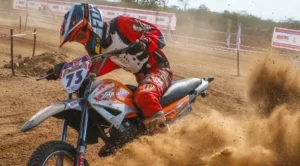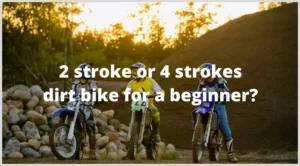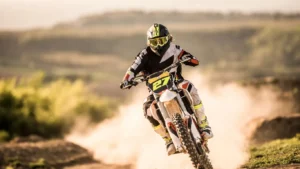The question of “how to do a wheelie” and “how to do the wheelie successfully” is one that new riders frequently ask since they always have the desire to perform feats and tricks on their bike. As a result, we’ll outline for you in this post the three easy stages needed to perform a wheelie on a dirt bike properly.
You may be interested in learning from a dirt bike wheelie trainer in order to learn how to ride professionally. You need not worry about whether or not you can perform a wheelie on a pit bike or a two-stroke dirt bike if you own one of those.
How To Wheelie a Dirt Bike Like?
Here’s a step-by-step method to perform a wheelie on a dirt bike:
Remember, performing a wheelie can be dangerous, so always wear protective gear, and practice in a safe and open area.
1. Find a safe and open area
Yes, finding a safe and open area is essential before attempting to perform a wheelie on a dirt bike. Look for a flat and open space that is free from obstacles, pedestrians, and other vehicles.
A large parking lot, an empty field, or an off-road trail are some examples of safe and suitable areas to practice. Make sure to also check the local laws and regulations regarding dirt bike riding in your area, as some places may have restrictions on where and when you can ride.
2. Adjust your body position
Adjusting your body position is crucial to perform a wheelie on a dirt bike successfully. Here’s how you can adjust your body position:
- Sit comfortably on the bike and grip the handlebars firmly.
- Shift your weight slightly backward towards the rear of the bike. You can do this by leaning back and pulling your hips towards the rear of the seat.
- Keep your arms straight but not locked, and your elbows relaxed.
- Keep your eyes focused on the horizon, and not on the front wheel or the ground.
- Make sure your feet are firmly placed on the footpegs, and your knees are bent to absorb any shocks or bumps.
- By adjusting your body position, you’ll be able to shift the weight of the bike towards the rear, making it easier to lift the front wheel off the ground.
3. Increase your speed
Increasing your speed is the next step in performing a wheelie on a dirt bike. Here’s how to do it:
- Start in first gear and begin riding at a moderate speed.
- Use the throttle to increase your speed gradually.
- As you gain speed, the front wheel will start to feel lighter.
- Keep your body position adjusted towards the rear of the bike to maintain your balance.
- Keep your eyes focused on the horizon, and not on the front wheel or the ground.
- By increasing your speed gradually, you’ll be able to feel the bike’s balance and adjust your body position accordingly.
- Once you feel comfortable at a moderate speed, you can try to increase the speed slightly more to lift the front wheel off the ground.
- Remember to be patient and take your time to get comfortable with the bike’s handling and your body’s position before attempting to lift the front wheel.
4. Pull up on the handlebars
Once you’ve gained enough speed and the front wheel starts to feel lighter, you can start to lift the front wheel off the ground by pulling up on the handlebars. Here’s how to do it:
- Keep your body position adjusted towards the rear of the bike to maintain your balance.
- Firmly grip the handlebars and keep your arms straight but not locked.
- Pull up on the handlebars using a smooth and controlled motion. This will lift the front wheel off the ground.
- Use your legs to grip the bike and maintain your balance.
- Keep your eyes focused on the horizon, and not on the front wheel or the ground.
- Remember to use a smooth and controlled motion when pulling up on the handlebars. Don’t jerk the handlebars, as this can cause you to lose your balance and potentially crash.
- Practice pulling up on the handlebars at different speeds until you find the right amount of force needed to lift the front wheel off the ground.
5. Control the height
Once you’ve lifted the front wheel off the ground, you’ll need to control the height of the wheelie. Here’s how to do it:
- Use the throttle to control the height of the wheelie. You can increase the height by applying more throttle or decrease the height by easing off the throttle.
- Keep your body position adjusted towards the rear of the bike to maintain your balance.
- Use your legs to grip the bike and maintain your balance.
- Keep your eyes focused on the horizon, and not on the front wheel or the ground.
- Remember to use the throttle in a smooth and controlled manner to maintain the height of the wheelie.
- Don’t apply too much throttle, as this can cause the bike to flip over. Similarly, don’t ease off the throttle too quickly, as this can cause the front wheel to drop suddenly and potentially cause you to lose control.
- Practice controlling the height of the wheelie at different speeds until you find the right balance.
6. Bring the front wheel back down
Knowing how to bring the front wheel back down safely is essential to successfully perform a wheelie on a dirt bike. Here’s how to do it:
- When you’re ready to bring the front wheel down, ease off the throttle gradually to reduce the height of the wheelie.
- Shift your weight forward by leaning your upper body towards the handlebars. This will help bring the front wheel back down.
- Apply the rear brake gently to lower the front wheel back to the ground. Be careful not to apply too much brake as this can cause the rear wheel to lock up and potentially cause you to lose control.
- Keep your body position adjusted towards the front of the bike to maintain your balance.
- Keep your eyes focused on the horizon, and not on the front wheel or the ground.
- Remember to ease off the throttle gradually and apply the brake gently to bring the front wheel back down safely.
- Practice bringing the front wheel down smoothly and gradually until you feel comfortable and confident doing so.
7. Practice
Practice is the key to mastering the skill of performing a wheelie on a dirt bike. Here are some tips for practicing safely:
- Start by practicing in a safe and open area that is free from obstacles, pedestrians, and other vehicles.
- Always wear the appropriate safety gear, including a helmet, goggles, gloves, and protective clothing.
- Start at a moderate speed and gradually increase your speed as you become more comfortable and confident.
- Practice adjusting your body position, pulling up on the handlebars, and controlling the height of the wheelie.
- Practice bringing the front wheel back down safely by easing off the throttle, shifting your weight forward, and applying the brake gently.
- Take breaks as needed to rest and avoid fatigue.
- Be patient and don’t get discouraged if it takes some time to master the skill.
- Remember, performing a wheelie on a dirt bike can be dangerous, and it’s important to practice safely and responsibly.
- Always follow the local laws and regulations regarding dirt bike riding in your area, and never attempt to perform a wheelie on a public road or in a crowded area.
Many stunts are there like wheelie which we have already discussed before so if you are also unaware of that then how to whip a dirt bike for beginners is a guide which will give you full steps on how to perform it.
Wheelie Practice Drills
Performing wheelies can be a fun and exciting way to test your riding skills, but it’s important to practice safely and gradually build up your confidence and control. Here are some wheelie practice drills that can help you improve your technique:
Power Wheelie:
Start by riding in first gear at a moderate speed, and then apply a quick and firm twist of the throttle while simultaneously pulling up on the handlebars. The goal is to lift the front wheel off the ground and hold it up for a short distance before bringing it back down. Practice this drill in a safe and controlled environment, such as an empty parking lot.
Clutch Control:
This drill involves using the clutch to control the height and duration of the wheelie. Start by riding in first gear at a moderate speed, and then pull in the clutch while simultaneously applying throttle and pulling up on the handlebars. Release the clutch smoothly and gradually to lift the front wheel off the ground, and then use the clutch to maintain the height and balance of the wheelie. Practice controlling the clutch and releasing it smoothly to bring the front wheel back down.
Slow Wheelie:
This drill involves lifting the front wheel off the ground and maintaining a slow and controlled wheelie without using excessive throttle or speed. Start by riding in first gear at a slow pace, and then gradually apply throttle while pulling up on the handlebars. Use your body weight and balance to maintain a slow and controlled wheelie, and then bring the front wheel back down smoothly.
Braking Wheelie:
This drill involves lifting the front wheel off the ground while applying the rear brake to control the height and duration of the wheelie. Start by riding in first gear at a moderate speed, and then apply the rear brake while simultaneously pulling up on the handlebars. Use the brake to maintain the height and balance of the wheelie, and then release the brake smoothly to bring the front wheel back down.
How To Do A Stand-up Wheelie on A Dirt Bike
Performing a stand-up wheelie on a dirt bike requires proper balance, control, and technique. Here are the steps to do a stand-up wheelie on a dirt bike:
Start by riding at a moderate speed in first gear. It’s important to be comfortable and familiar with your dirt bike before attempting this trick.
Stand up on the footpegs with your knees bent and your feet positioned on the middle of the footpegs. Keep your arms relaxed and slightly bent.
Shift your weight slightly back towards the rear of the dirt bike, and apply steady throttle while pulling up on the handlebars.
As the front wheel begins to lift off the ground, use your legs to balance the dirt bike and maintain your position. Keep your eyes focused on the horizon and your arms relaxed to avoid jerky movements.
To bring the front wheel back down to the ground, gradually release the throttle and shift your weight forward towards the handlebars.
Practice the stand-up wheelie on a flat surface before attempting it on an incline or a hill. Gradually increase your speed and the height of the wheelie as you gain more confidence and control.
Remember, performing a stand-up wheelie on a dirt bike is a high-risk maneuver that should only be attempted by experienced riders. Always wear appropriate safety gear such as a helmet, gloves, and protective clothing to minimize the risk of injury in case of a fall.
How to Perform Nose Wheelie?
Performing a nose wheelie on a motorcycle, also known as a “stoppie,” is a trick that requires balance and control. Here are the steps to perform a nose wheelie on a motorcycle:
Begin riding at a moderate speed on a flat and smooth surface. It’s important to be comfortable and familiar with your motorcycle before attempting this trick.
Shift your weight forward towards the handlebars, and use your front brake to slow down the motorcycle. It’s crucial to apply the front brake smoothly and gradually to avoid skidding or losing control.
Once you have slowed down to a near stop, continue to shift your weight forward and apply more pressure to the front brake to lift the rear wheel off the ground. The amount of pressure needed will depend on the weight of your motorcycle and your riding style.
As the rear wheel lifts off the ground, keep your eyes focused on the horizon and maintain your balance by adjusting your body position and the pressure on the front brake.
To bring the motorcycle back down, gently release the front brake and shift your weight backward towards the rear wheel.
Practice the nose wheelie on a flat surface before attempting it on a slope or an incline. Gradually increase your speed and the amount of pressure on the front brake as you gain more confidence and control.
Remember, performing a nose wheelie on a motorcycle is a high-risk maneuver that should only be attempted by experienced riders.
Always wear appropriate safety gear such as a helmet, gloves, and protective clothing to minimize the risk of injury in case of a fall.
Most Common Wheeling Mistakes You Should Avoid:
Performing a wheelie can be a thrilling experience, but it’s important to be aware of the potential risks and common mistakes that can happen. Here are some of the most common wheelie mistakes you should avoid:
Overconfidence: Many riders attempt to perform a wheelie without proper training or experience, which can lead to accidents and injuries. Always start with small wheelies and gradually build up your skills and confidence.
Incorrect Body Position: Proper body positioning is crucial for balancing the motorcycle during a wheelie. Avoid leaning too far back or forward and keep your arms relaxed to maintain control.
Poor Timing: The timing of your acceleration and clutch release is critical for lifting the front wheel off the ground. If you release the clutch too quickly or apply too much throttle, you may lose control of the motorcycle.
Lack of Concentration: Performing a wheelie requires full concentration and attention. Avoid distractions such as music or talking to passengers, as this can lead to accidents.
Over-Revving: Over-revving the engine can cause the front wheel to lift too quickly and result in a loss of control. Always use smooth and controlled throttle inputs to avoid sudden jerks.
Failure to Cover the Rear Brake: Covering the rear brake is essential for maintaining control during a wheelie. If the front wheel lifts too high, gently apply the rear brake to bring it back down.
Remember, safety should always be your top priority when performing a wheelie. Use a helmet, gloves, and protective clothes when wheeling, and avoid public roads and heavy traffic.
Practice in an empty parking lot and always have a spotter.






